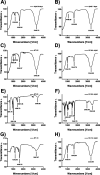Controlling Amyloid Beta Peptide Aggregation and Toxicity by Protease-Stable Ligands
- PMID: 37101809
- PMCID: PMC10125337
- DOI: 10.1021/acsbiomedchemau.2c00067
Controlling Amyloid Beta Peptide Aggregation and Toxicity by Protease-Stable Ligands
Abstract
Polymerization of soluble amyloid beta (Aβ) peptide into protease-stable insoluble fibrillary aggregates is a critical step in the pathogenesis of Alzheimer's disease (AD). The N-terminal (NT) hydrophobic central domain fragment 16KLVFF20 plays an important role in the formation and stabilization of β-sheets by self-recognition of the parent Aβ peptide, followed by aggregation of Aβ in the AD brain. Here, we analyze the effect of the NT region inducing β-sheet formation in the Aβ peptide by a single amino acid mutation in the native Aβ peptide fragment. We designed 14 hydrophobic peptides (NT-01 to NT-14) by a single mutation at 18Val by using hydrophobic residues leucine and proline in the natural Aβ peptide fragment (KLVFFAE) and analyzed its effect on the formation of Aβ aggregates. Among all these peptides, NT-02, NT-03, and NT-13 significantly affected the Aβ aggregate formation. When the NT peptides were coincubated with the Aβ peptide, a significant reduction in β-sheet formation and increment in random coil content of Aβ was seen, confirmed by circular dichroism spectroscopy and Fourier transform infrared spectroscopy, followed by the reduction of fibril formation measured by the thioflavin-T (ThT) binding assay. The aggregation inhibition was monitored by Congo red and ThT staining and electron microscopic examination. Moreover, the NT peptides protect the PC-12 differentiated neurons from Aβ-induced toxicity and apoptosis in vitro. Thus, manipulation of the Aβ secondary structure with protease-stable ligands that promote the random coil conformation may provide a tool to control the Aβ aggregates observed in AD patients.
© 2023 The Authors. Published by American Chemical Society.
Conflict of interest statement
The authors declare no competing financial interest.
Figures










Similar articles
-
Hydrophobic C-Terminal Peptide Analog Aβ31-41 Protects the Neurons from Aβ-Induced Toxicity.ACS Chem Neurosci. 2024 Jun 19;15(12):2372-2385. doi: 10.1021/acschemneuro.4c00032. Epub 2024 Jun 1. ACS Chem Neurosci. 2024. PMID: 38822790
-
(R)-α-trifluoromethylalanine containing short peptide in the inhibition of amyloid peptide fibrillation.Biopolymers. 2015 Sep;104(5):601-10. doi: 10.1002/bip.22670. Biopolymers. 2015. PMID: 25968595
-
Peptide and protein mimetics inhibiting amyloid beta-peptide aggregation.Acc Chem Res. 2008 Oct;41(10):1309-18. doi: 10.1021/ar8000475. Acc Chem Res. 2008. PMID: 18937396
-
Electrochemistry of Alzheimer Disease Amyloid Beta Peptides.Curr Med Chem. 2018;25(33):4066-4083. doi: 10.2174/0929867325666180214112536. Curr Med Chem. 2018. PMID: 29446720 Review.
-
Physicochemical characteristics of soluble oligomeric Abeta and their pathologic role in Alzheimer's disease.Neurol Res. 2005 Dec;27(8):869-81. doi: 10.1179/016164105X49436. Neurol Res. 2005. PMID: 16354549 Review.
Cited by
-
A Snake Venom Peptide and Its Derivatives Prevent Aβ42 Aggregation and Eliminate Toxic Aβ42 Aggregates In Vitro.ACS Chem Neurosci. 2024 Jul 17;15(14):2600-2611. doi: 10.1021/acschemneuro.4c00089. Epub 2024 Jul 3. ACS Chem Neurosci. 2024. PMID: 38957957 Free PMC article.
-
Protection of Si Nanowires against Aβ Toxicity by the Inhibition of Aβ Aggregation.Molecules. 2024 Apr 25;29(9):1980. doi: 10.3390/molecules29091980. Molecules. 2024. PMID: 38731472 Free PMC article.
-
The Aβ42:Aβ40 ratio modulates aggregation in beta-amyloid oligomers and drives metabolic changes and cellular dysfunction.Front Cell Neurosci. 2024 Dec 5;18:1516093. doi: 10.3389/fncel.2024.1516093. eCollection 2024. Front Cell Neurosci. 2024. PMID: 39717390 Free PMC article.
References
-
- Roher A. E.; Lowenson J. D.; Clarke S.; Woods A. S.; Cotter R. J.; Gowing E.; Ball M. J. Beta-Amyloid-(1-42) Is a Major Component of Cerebrovascular Amyloid Deposits: Implications for the Pathology of Alzheimer Disease. Proc. Natl. Acad. Sci. 1993, 90, 10836–10840. 10.1073/pnas.90.22.10836. - DOI - PMC - PubMed
LinkOut - more resources
Full Text Sources
Other Literature Sources
Research Materials

